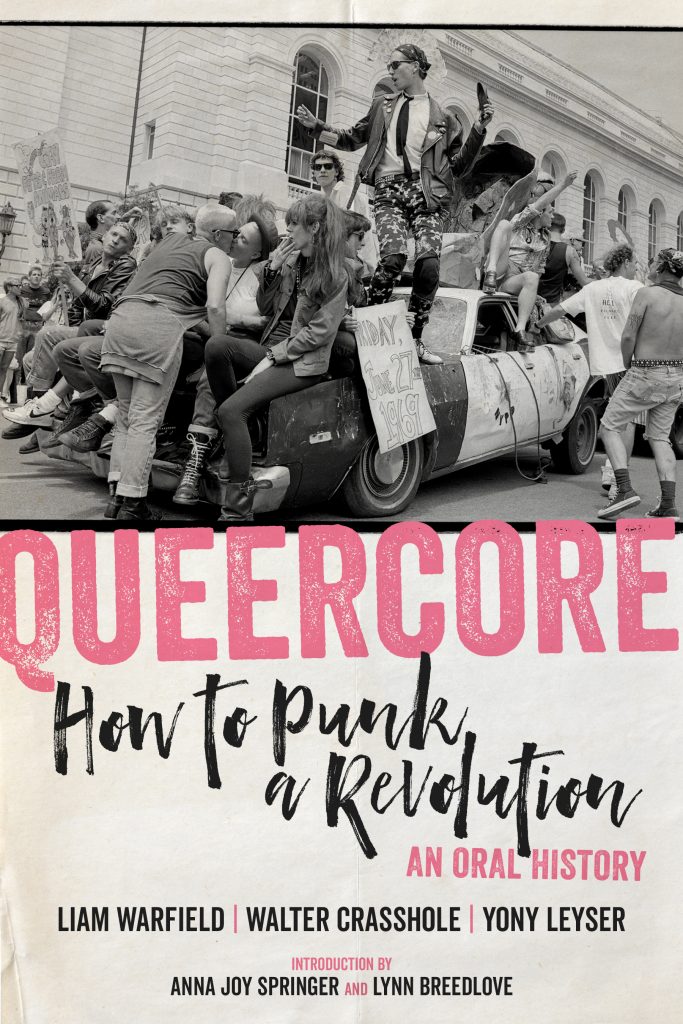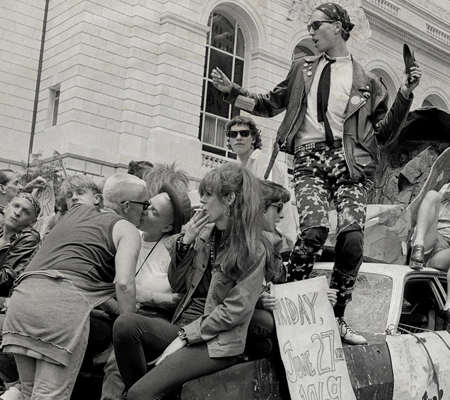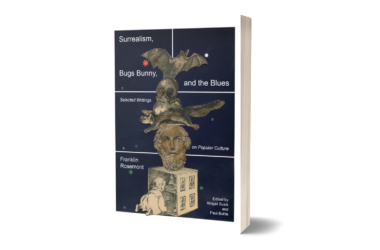Berlin journalist Walter Crasshole on queercore, the explosive countercultural fusion of LGBTQ and punk/hardcore.
By Maurice Frank
Berliner Zeitung
Berlin – Journalist Walter Crasshole (Exberliner, Siegessäule), alongside writer Liam Warfield and filmmaker Yony Leyser, is co-editor of
, a book based on interviews from the eponymous film by Leyser. It documents a cultural moment in North America where punk and hardcore merged with queer culture to produce an explosion of underground music, fashion, art, zines and film – a movement that raised a middle figure to every sort of mainstream.
How did you get involved in this book?
Yony found me a while ago and tapped me to work on the film. I did some of the interviews. I interviewed John Waters, Bruce la Bruce, Larry Livermore. Yony brought up the idea with me and Liam that we do something with the transcripts as a book. Some of the characters didn’t make it into the film and there was a lot of drama about that: Jayne County, for example. She was this queer icon, this out transsexual rock ‘n’ roll woman back in the 1970s, but she didn’t make it into the film because film is a different animal. We did the book to refocus the spotlight onto some of these people.
Where do queer and punk overlap?
I don’t want to say punk is a marginalised identity. It’s more of a subculture, but both groups are made up of people who feel like outsiders and have been made to feel like outsiders. Punks were always: “We’re gonna fuck the system, we’re gonna do it our way. We’re gonna teach ourselves to make this music and this art, these films, because we don’t agree with overall society.” And queers have been pushed a little bit more in that direction rather than choosing it for themselves. That’s where I’d say they overlap. Being queer, they had a much more concrete agenda: gay liberation, etc. There’s not one concrete thing that punk rock was really trying to fight.
Queercore, or queer punk, was like the outsider among the outsiders. It clashed with mainstream gay culture and not just with mainstream heteronormative culture.
Absolutely, they were fighting against heteronormativity and assimilation. I think they recognised that’s not going to work, especially when the AIDS crisis was beginning to really hit hard and people were just dying by the thousands. It was not the time to buy a house, get as normal and as normative as you can.
Why an oral history?
Oral histories are a great way for the protagonists to tell the story themselves. It’s their story. It isn’t my story. I’m queer, I’m a punk, but I wasn’t in Toronto or San Francisco in the 1980s.
It was a very analogue, hands-on culture. What effect did the internet have on it?
I don’t think the internet is to blame for any loss of subculture. It’s just a new way of communication. It’s great that all this stuff is now scanned and put online. This shit is all free. That’s kind of punk rock.
A graphic in the book says: “Gun ‘em down. Looking for straight-acting gays.” Pretty edgy. How would that go down on Twitter today?
It’s totally edgy. I think people just had a different sense of humour. People used humour to make an impactful statement. I think that’s somewhat changed. The internet has democratised everything. I think it’s okay that it’s unacceptable to say certain things today that were acceptable back then. Although I’m happy people said it back then. Some of that shit is pretty great. Anyway, all of it’s punching up. It’s not like it’s complaining about liberal snowflakes – this was punching up against a government that was ignoring thousands of dead gay men.
Was queercore a mostly male scene?
No! I did a count on this. It’s about 50-50 in terms of the protagonists in the book. I think because G.B. Jones and Fifth Column are so iconic when it comes to queercore. Tribe 8, the really radical dyke hardcore band, are also something you think of. In terms of the imagery, this was a lesbian band at the time.
Has queercore spilled over into Berlin?
As far as these bands being iconic enough for young punks or queers to know, yes. Limp Wrist plays here quite often. In terms of the actual scene, Berlin was doing its own thing. And there’s a thriving underground scene: Köpi, for example. Lynn Breedlove [of queercore band Tribe 8] is here every now and again. Bruce LaBruce has set so many of his films in Berlin. His movie Saint-Narcisse is
at Freiluftkino Kreuzberg and he’s going to be present.
You write about Peaches as someone in whom the queercore spirit lives on – and who had a huge impact on Berlin.
I always found her very punk rock. Performativity on stage. How she puts herself out there. She was quite aggressive in a cool way. She was always pushing the boundaries of what was acceptable, particularly in gender.







